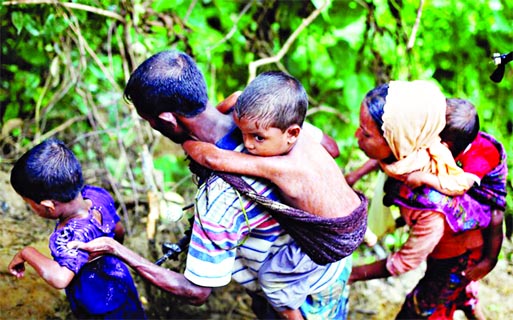
Staff Reporter :
Intermitted rains compounded the misery for hundreds of thousands of Rohingya refugees still without shelters at many points of no man’s land area since Thursday.
Besides, the rains also pounded their makeshift structures, adding to the misery of many refugees who live in structures made of sticks and pieces of cloth.
Apart from these, Myanmar Army planted landmines along border with Bangladesh posing deadly threat to fleeing Rohingya.
They do not have food or shelter and their children were seen running around half-naked while adults barefoot — all in torn clothes telling the tale of their journey.
Families mark out any space they can with whatever they can find. Makeshift houses are being built with pieces of tarpaulin, broken umbrellas and bits of plastic.
“We are living in plight, we left our homes, lost our everything so we ask everyone to help us survive,” said a mother along with her five children now staying at a makeshift house at Kutapalong of Cox’s Bazar district on Saturday.
She said her family members are passing sleepless night after their makeshift home crumbled by the rain. “We are starved and we don’t have enough help.” A woman was cooking their meal for the day, a few handfuls of rice over an open fire. The woman told media that they fled after their village was burned down, but her husband and son died before they could escape. “We need food for the children,” she said. “We have no idea where we will go from here, we are just following what everyone else is doing.” The UN says an “alarming” number of refugees have come into Bangladesh in the past two weeks. But the conditions they come into are also alarming. Quoting Rohingyas, Vivian Tan, spokesperson, UN’s refugee agency (UNHCR) told media said a helicopter came and dropped something onto their village, and a number of them reported shootings. Some said they lost family members. They said they hid in jungles, in mountains, and they helped each other because of the difficult conditions. And there were also quite a few stories about babies being born along the way.
Many have either lost their parents in the violence or along the way as they fled. Some are with aunts or neighbours. Others, however, are completely alone. Nearly 300,000 Rohingya Muslims have fled Myanmar’s Rakhine state into Bangladesh in the 15 days since new violence erupted, the United Nations said Saturday.
The figure has jumped about 20,000 in a day.
“Some 290,000 Rohingya arrived in Bangladesh since August 25,” said Joseph Tripura, a spokesman for the UN refugee agency.
Officials said the UN has found more Rohingya in villages and areas, which were previously not included by relief agencies.
Most of the Rohingyas are arriving by foot or boat across Bangladesh’s 278 kilometre border with Myanmar, a fourth of which is made up by the Naf River. The UN said there was a sharp increase in arrivals on Wednesday, when more than 300 boats arrived in Bangladesh. On Thursday, the UN had put the number at 164,000.
Refugee camps near Bangladesh’s border with Myanmar already had about 300,000 Rohingya before the upsurge in violence and are now overwhelmed.The tens of thousands of new arrivals have nowhere to shelter from monsoon rains. Most have walked for days and the UN says many are sick, exhausted and in desperate need of shelter, food and water.
Myanmar’s security forces planted internationally banned antipersonnel landmines along its border with Bangladesh which have seriously injured at least three civilians, including two children, and reportedly killed one man in the past week, Amnesty International (AI) confirmed on Saturday. “The Myanmar military’s callous use of inherently indiscriminate and deadly weapons at highly trafficked paths around the border is putting the lives of ordinary people at enormous risk,” said Tirana Hassan, Amnesty International’s Crisis Response Director, who is currently near the Bangladesh-Myanmar border.
“The Myanmar Army is one of only a handful of state forces worldwide, along with North Korea and Syria, to still openly use antipersonnel landmines. Authorities must immediately end this abhorrent practice against people who are already fleeing persecution.”
Some of the mines have been found near Taung Pyo Let Wal (also known as Tumbro) in Myanmar’s Rakhine state on the edge of the border with Bangladesh. Many have fled the area to a makeshift refugee camp inside Bangladesh, but make frequent trips back across the border to bring supplies or to help others to cross.
In one incident, on September 3, a woman in her 50s crossed the border from Bangladesh into Taung Pyo Let Wal and stepped on a landmine on the way back. She is being treated in a Bangladeshi hospital after her leg was blown off from the knee down.
One of her relatives, Kalma, 20, told AI: “My mother-in-law went to our village [from the camp] to fetch water to take a shower.
A few minutes later I heard a big explosion and I heard someone had stepped on a mine. It was only later I realized it was my mother-in-law.” Several eyewitnesses said they had seen Myanmar security forces, including military personnel and Border Guard Police, plant mines close to the Myanmar-Bangladesh border.
AI verified the authenticity of graphic mobile phone images showing the woman’s shredded legs immediately after the blast.
Medical experts concluded from the nature of the injury that it was caused by an explosive device that was powerful, directed upwards and located on the ground, all of which is consistent with a landmine.

